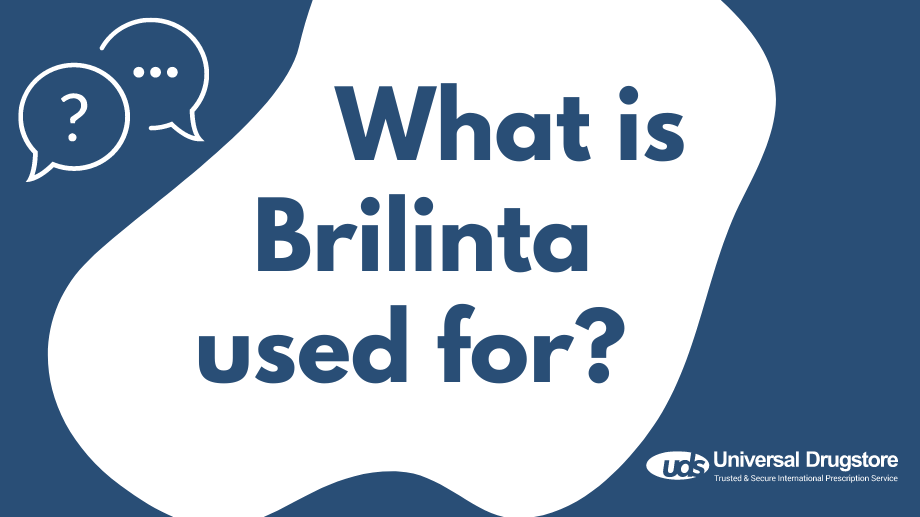What is Brilinta used for?

Cardiovascular disease (CVD) was the leading cause of death in the U.S. in the year 2020, accounting for over 928,000 deaths. Of these deaths, coronary heart disease (CHD), the disease that causes heart attacks, was the leading cause at 41.2%, followed by stroke at 17.3%, and high blood pressure at 12.9%. Brilinta (ticagrelor) is an antiplatelet medication that prevents platelets in your blood from sticking together to form unwanted blood clots that could block an artery. It is used to lower your risk of stroke, heart attack, or death due to a blockage of blood flow to the heart or a previous heart attack. Brilinta is manufactured by AstraZeneca and is only approved for use in adults 18 years of age and older.
Read on as we discuss what Brilinta is used for, its side effects, precautions, and other important information you need to know.
What is Brilinta prescribed for?
Brilinta (ticagrelor) is considered a P2Y12 platelet inhibitor. It is approved by the FDA to:
- Lower the risk of cardiovascular death, myocardial infarction (heart attack), and stroke if you have acute coronary syndrome (ACS), unstable angina (severe chest pain), or a previous heart attack
- Lower the risk of blood clots following a stent placement in one or more blood vessels in your heart
- Lower the risk of a first-time heart attack or stroke if you have coronary artery disease (CAD) and are at a higher risk for heart attack or stroke
- Lower the risk of stroke if you have an acute ischemic stroke or high-risk transient ischemic attack
Brilinta FAQs
How does Brilinta work?
Platelets help form blood clots to stop bleeding from injuries. Blood clots can be dangerous if they form in your blood vessels and stop blood flow because this can lead to a stroke or heart attack. Brilinta prevents platelets from clumping together to form dangerous blood clots, which reduces your risk of a stroke or heart attack.
What are the possible side effects of Brilinta?
The most common side effects of Brilinta include:
- Shortness of breath
- Bleeding including nosebleeds
- Diarrhea
- Dizziness
- Nausea
- Slow heart rate
Brilinta can rarely cause serious side effects such as:
- Severe, life-threatening allergic reactions (hives, swelling of your tongue or throat, and trouble breathing)
- Increased risk of serious bleeding, especially if taken with other anticoagulants or blood thinners
- Liver problems
These are not all of the possible side effects of Brilinta. You should always seek medical advice from your healthcare professional for any questions or concerns about your medical condition or treatment. Read all medication guides or drug information sheets that come with this medication. You can report side effects to FDA at 1-800-FDA-1088 or www.fda.gov/medwatch.
Are there any drug interactions with Brilinta?
When Brilinta is taken with other drugs, it can change how Brilinta works or make some side effects more likely or severe. You should ask your healthcare provider if any of the prescription drugs, over-the-counter (OTC) drugs, vitamins, or supplements you take may interact with Brilinta, including:
- Cholesterol medications such as simvastatin and lovastatin
- Antifungal medications such as ketoconazole, itraconazole, and voriconazole
- Seizures medications such as carbamazepine, phenobarbital, and phenytoin
- HIV medications such as ritonavir and atazanavir
- Macrolide antibiotics such as clarithromycin
- Antiplatelet drugs such as clopidogrel
- Blood thinners such as warfarin
- NSAIDs such as ibuprofen and naproxen
- Rifampin
- Digoxin
- Nefazodone
What should you tell your doctor before starting Brilinta?
Before starting Brilinta, be sure your healthcare provider is aware of all your medical conditions, including:
- Active bleeding or signs of internal bleeding such as black or bloody stools, red, pink, or brown urine, or coughing up blood or vomit that looks like coffee grounds
- Heart rhythm problems
- Liver disease
- Take a dose of aspirin that is more than 100 mg per day
- Are pregnant or plan on becoming pregnant
- Are breastfeeding as Brilinta’s use is not recommended during lactation
Is Brilinta a blood thinner?
The active ingredient in Brilinta, ticagrelor, belongs to the antiplatelet drug class. Antiplatelets are considered a type of blood thinner.
What is the dose for Brilinta?
For ACS or a history of heart attack:
- Start treatment with a 180 mg loading dose of Brilinta. That should be followed by a 90 mg tablet twice a day during the first 12 months. After 12 months, give 60 mg of Brilinta twice a day.
For CAD and no previous stroke or heart attack:
- Give 60 mg of Brilinta twice a day.
For acute ischemic stroke:
- Start treatment with a 180 mg loading dose of Brilinta then continue with a 90 mg tablet twice a day for up to 30 days.
Use Brilinta with a maintenance dose of aspirin of 75 mg to 100 mg daily.
How long should you take Brilinta after a stent?
Brilinta is usually taken along with aspirin for 6 to 12 months, or longer, after a stent to help prevent blood clots. Your dose and how long you take Brilinta will be determined by your healthcare provider.
What should you do if you miss a dose of Brilinta?
If you miss a dose of Brilinta, you should skip the missed dose and take your next dose (1 tablet) at its next scheduled time.
Related medications
- Plavix (clopidogrel)
- Effient (prasugrel)
- Coumadin (warfarin)
- Aspirin (acetylsalicylic acid)
- Aggrenox (dipyridamole/ASA)
Sources
- Brilinta Package Insert: https://den8dhaj6zs0e.cloudfront.net/50fd68b9-106b-4550-b5d0-12b045f8b184/565ceafd-fbe3-4573-9c39-19280af566ec/565ceafd-fbe3-4573-9c39-19280af566ec_viewable_rendition__v.pdf
- National Library of Medicine: https://www.ncbi.nlm.nih.gov/pmc/articles/PMC3474441/
- Brilinta HCP: https://www.brilintahcp.com/
- Medscape: https://reference.medscape.com/drug/brilinta-ticagrelor-999674
- Prescriber’s Digital Reference: https://pdr.net/drug-summary/Brilinta-ticagrelor-64